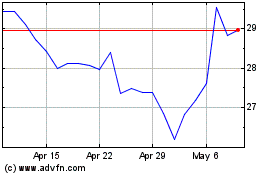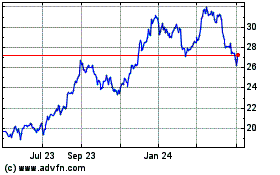Brexit' Shockwaves Ripple Through Eurozone Markets
June 24 2016 - 4:20AM
Dow Jones News
Eurozone markets prepared for a violent selloff early Friday as
investors reacted to the U.K. voting to exit the European Union, an
event many analysts say could bolster anti-European sentiment in
many nations in the common currency area.
Futures on the headline Euro Stoxx 50 index were down nearly 12%
about an hour before the stock markets opened, with futures on the
German Dax and the French CAC 40 trading 9.5% and 10.5% lower,
respectively.
Changes in futures don't always reflect market moves after
trading starts, but they are considered a broad gauge of investor
sentiment on that day.
On early Friday, the euro was 3% lower against the U.S. dollar
compared with Thursday's close and 6% down against the Japanese
yen, which is the world's top haven currency for investors. It rose
4% against the pound, which was the hardest hit by Britain's
decision to leave the EU.
While the outcome of the referendum is set to shake all stock
markets in the eurozone, investors and analysts believe it will
ripple unevenly across different countries.
In Germany, yields on 10-year sovereign bonds, or bunds, turned
negative earlier in the month for the first time in recorded
history and currently hover slightly above zero. Investors flocked
into them in a dash for safety, on the back of uncertainty
surrounding the U.K. referendum and lackluster economic data in the
U.S.
Yields move opposite to prices, meaning higher demand for bunds
is likely to push them subzero again.
"Bunds look set to open at new record highs," said Christoph
Rieger, analyst at German lender Commerzbank AG, who warned about a
"flight" from peripheral Eurozone countries.
Indeed, nations like Italy, Spain and Ireland are likely to bear
the brunt of market concerns. Over the past month, yields on their
sovereign bonds have edged up compared with Germany's, a sign that
investors consider the debt of these nations to be riskier.
Analysts have long warned about the strong links between
eurozone countries' sovereign risk and the health of their banks,
whose balance sheets are loaded up on debt from their own
governments. This means peripheral banks are also potentially at a
higher risk.
Investors are now trusting policy makers—chiefly at the Bank of
England and the European Central Bank—to prevent any market panic.
Since the financial crash in 2008, central banks in the world's
most developed economies have put in place foreign-exchange swap
lines between them, which allow them to readily offer their banks
liquidity in other currencies if needed.
Markets are also betting on central banks providing extra rounds
of liquidity on short notice.
"The big, big focus will be in maintaining liquidity," said Bill
O'Neill, head of the U.K. investment office at UBS Wealth
Management. "The ECB needs to do anything to continue easing the
credit cycle."
The Bank of England issued a statement early Friday saying it
had "undertaken extensive contingency planning and is working
closely with [the U.K.] Treasury, other domestic authorities and
overseas central banks."
Nevertheless, the Continent is likely to keep grappling with the
consequences of Britain's EU exit for many months to come. Analysts
underscore that such an unprecedented decision to leave the
bloc—the first time a sovereign country has done so—is set to fuel
other euroskeptic movements in the eurozone, such as the French
National Front and Austria's Freedom Party.
Holger Schmieding, chief economist at Berenberg Bank, noted that
parliaments in other EU countries are still "very unlikely" to
follow the U.K.'s footsteps and schedule a similar referendum, but
said this wouldn't stop markets from seeing risks "through a
different prism."
"Whether or nor there are new risks there that that weren't
there before is a different matter," he added.
Write to Jon Sindreu at jon.sindreu@wsj.com
(END) Dow Jones Newswires
June 24, 2016 04:05 ET (08:05 GMT)
Copyright (c) 2016 Dow Jones & Company, Inc.
UBS (NYSE:UBS)
Historical Stock Chart
From Mar 2024 to Apr 2024

UBS (NYSE:UBS)
Historical Stock Chart
From Apr 2023 to Apr 2024
